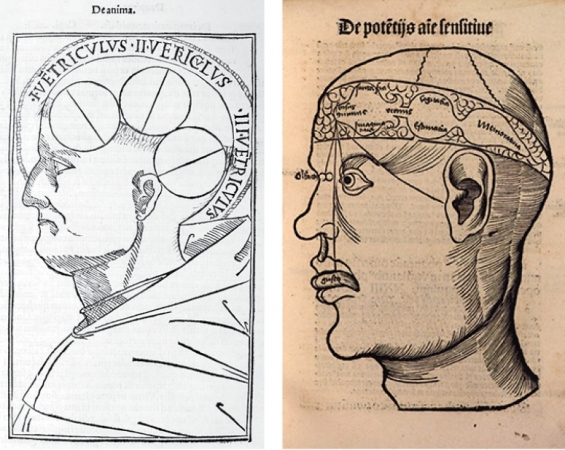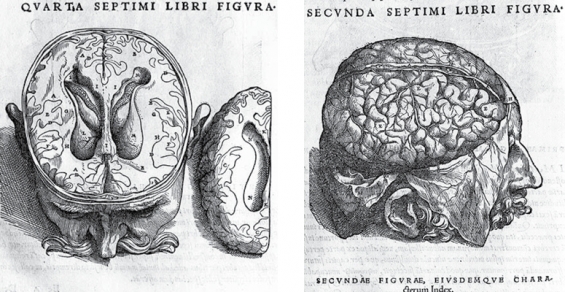
In these books, as well as in “Margarita Philosophica” by Gregor Reisch, 1508, in Olin Library special collections, we find highly schematic pictures of the brain showing three or four circles or cells. They represent the medieval cell doctrine of brain function, which states that cognition and memory were stored in the cerebral ventricles, or fluid-filled interior spaces of the brain. This is very different from our modern understanding that mental processes are localized in different parts of the cerebral cortex.
The roots of the medieval cell doctrine go back to Aristotle’s (384-322 B.C.) ideas on cognition. He thought that the five senses came together in the head in a place called “sensus communis,” or common sensory input, where mental images were formed. The images were interpreted by cognitive processes and later stored in memory. By the fifth century, Augustine and Nemesius, the Bishop of Emesa had assigned components of Aristotle’s cognitive ideas to the cerebral ventricles (Whitaker, 2007, p. 45).
One highly schematic illustration of ventricles of the brain (above) is found in the fifth table of anatomy in “Fasciculus medicinae, 1491” (1988 facsimile). The ventricles are labeled with their function from front to the back of the head as follows:
1. Common sense
2. Cell of the imaginative faculty
3. Cell of the estimative or rational thinking faculty
4. Cell of the faculty of memory (Ketham, 1988, p. 64)
Becker Library’s 1496 edition of “Philosophia Pauperum” contains only three ventricles or cavities in its illustration of the brain (below left). They consist of the anterior, a small posterior and the middle, not so much a ventricle as a passageway between the anterior and posterior (Clarke, 1972, p. 23). Albertus Magnus asserted that the anterior ventricle was connected to judgement, the posterior ventricle to memory and the intermediate position to imagination (Weisheipl, 1980).

Andreas Vesalius comments on the cell doctrine in De Fabrica. He mentions Gregor Reisch’s illustration (above right), with its three ventricles and in so doing he cast doubt on its accuracy (Sutherland-Foggio, 2017, pp. 6-8). The following is from the 1952 translation by Charles Singer rather than the 2014 translation by Garrison and Hast as attributed by Sutherland-Foggio:
I can in some degree follow the brain’s functions in dissections of living animals, with sufficient probability and truth, but I am unable to understand how the brain can perform its office of imagining, meditating, thinking, and remembering, or, following various doctrines, however you may wish to divide or enumerate the powers of the Reigning Soul. (Singer, 1952, p. 4)(Sutherland-Foggio, 2017, pp. 8)
In De Fabrica, Vesalius calls the cell doctrine into question and presents the most accurate brain illustrations to date (lateral ventricles, below left; and cerebral cortex, below right). He doesn’t suggest an alternative theory to the cell doctrine of brain function. That comes a hundred years later. (Sutherland-Foggio, 2017)

Sources
Albertus, o. O. (1496). Philosophia pauperum. Venetiis: Georgium de Arriuabenis, 31 August , 1496. Retrieved from http://beckercat.wustl.edu/cgi-bin/koha/opac-detail.pl?biblionumber=141099
Clarke, E. &. (1972). An illustrated history of brain function. Oxford: Sandford Publications. Retrieved from http://beckercat.wustl.edu/cgi-bin/koha/opac-ISBDdetail.pl?biblionumber=47905
Ketham, J. d. (1988). The Fasciculus Medicinae of Johannes de Ketham, Alemanus : facsimile of the first (Venetian) edition of 1491 / with English translation by Luke Demaitre ; commentary by Karl Sudhoff ; translated and adapted by Charles Singer. Birmingham, Ala: The Classics of Surgery Library. Retrieved from http://beckercat.wustl.edu/cgi-bin/koha/opac-detail.pl?biblionumber=13906
Manzoni. (1998, Mar). The cerebral ventricles, the animal spirits and the dawn of brain localization of function. Arch Ital Biol., 136(2), 103-152.
Reisch, G. -1. (1508). Margarita philosophica cum additionibus novis:. Basilee :: Michael Furter and Jo. Schott,. Retrieved from http://catalog.wustl.edu/record=b2073944
Sutherland-Foggio. (2017, Oct). Developing the Brain-Early Illustrations of Cerebral Cortex and Its Gyri. Pediatr Neurol., 75, 6-10 (page 8 quote from De Fabrica).
Singer, C. (1952). Vesalius on the Human Brain: introduction, translation of text, translation of descriptions of figures, notes to the translations, figures. London, New York, Toronto: Published for the Wellcome Historical Medical Museum by Geoffrey Cumberlege, Oxford University Press.
Vesalius, A. 1.-1. (1543). Andreae Vesalii Bruxellensis, scholae medicorum Patauinae professoris De humani corporis fabrica libri septem … Basileae: anno salutis reparatae 1543. Mense Iunio. Retrieved from http://beckercat.wustl.edu/cgi-bin/koha/opac-detail.pl?biblionumber=86722
Weisheipl, J. A. (1980). Albertus Magnus and the Sciences: Commemorative Essays 1980. 520.
Whitaker, H. (2007). Was medieval cell doctrine more modern than we thought. In H. S. Cohen, Consciousness and Cognition : Fragments of Mind and Brain (p. 45). London.: Academic Press. Retrieved March 2, 2017
